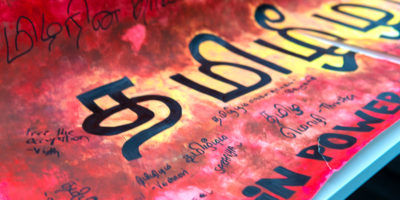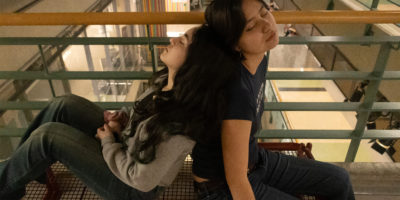By Zachary Roman and Kieona George
Ryerson’s third-ever powwow, which took place on Sept. 20, showed potential for Indigenous culture celebration to extend beyond a one-day event, said Riley Kucheran, a member of Biigtigong Nishnaabeg First Nation and an incoming professor at the School of Fashion.
The powwow was preceded by a week of educational programming and featured an outdoor venue and more artisan vendors than last year. It also featured discussion panels, hide tanning, a beading circle, film screenings, a powwow dance fitness class, medicine teachings and walking tours of Ryerson.
“It’s really moving to see Indigenous presence in urban spaces like this. It is resistance, it is active decolonization,” said Kucheran.
The university hosted its first powwow in the late 90s, organized by Ryerson Aboriginal Student Services. Last year, Kucheran, along with Laura Heidenheim, who were graduate students at the time, relaunched the Ryerson powwow—20 years after the first one.
Immediately after the 2018 powwow, Kucheran and Heidenheim started to think about what they wanted for the upcoming year. Anthony Warren and Josie Slaughter, co-chairs of this year’s Ryerson Pow Wow, joined the team and were mentored by Kucheran and Heidenheim to create this year’s week-long affair. Kucheran said it was a collaborative effort.
Ryerson powwow as a form of resilience
Traditionally, powwows are occasions in Indigenous communities for nations, families and friends to gather, dance, share news, eat food, celebrate and trade. Contemporary powwows are celebrations of Indigenous culture.
Ryerson community members organizing a powwow also has significance due to the university’s founder and still-standing statue of Egerton Ryerson.
Egerton Ryerson is known as a significant contributor to the framework for the residential school system in Canada. Residential schools subjected Indigenous children to immeasurable abuse and trauma and played a large role in the genocide of Indigenous peoples in Canada.
Warren said that holding a powwow at Ryerson is a powerful show of resilience.
“Powwow means a resurgence of our cultures; showing that we’re resilient people,” said Warren. “Despite the barriers that the colonial system has put in front of us, we are still thriving and surviving.”
Highlighting Indigenous art, tech and teachings
Jenna Barnhardts, fourth-year biomedical science student from Tyendinaga Mohawk Territory, sold her handmade art at her booth. “Yarnhardts,” the name she gave her merchandise, featured hand-knitted mittens, hats and handmade earrings. She sold alongside fourth-year biomedical science student Ashley Buttineau, who is Métis.
“My grandmother taught me to knit,” said Barnhardts. She learned how to make her earrings at an Indigenous workshop last May. “My friend showed me how to do [cross stitch] and dreamcatchers. I learned at school when I was really young.”
Barnhardts has danced at powwows for almost 20 years of her life. She said she’s happy the Ryerson Pow Wow is back.
“I grew up on a reservation so we always had powwow.” said Barnhardts. “It’s part of who I am.”
SciXchange coordinator of Indigenous knowledge and science outreach, Amber Sandy, used the Ryerson Pow Wow education week to show how Indigenous peoples are “natural scientists.”
To showcase Indigenous technology, hide tanning took place from the Wednesday to the Friday.
The process began a week before when the skins were taken out of the freezer and soaked in a lye solution, which helps swell the skins. On Wednesday, the fur was scraped. On Thursday, the inside membrane was scraped, and the hides were soaked overnight in a mixture of deer brains and water, which makes them soft.
On Friday at the Pow Wow, the hides were wrung out and stretched across wood and softened, some by hand. The final stage meant sewing the hides into a pocket with a fire beneath them with rotten wood, giving them the smell and colour of finished hide.
“It’s less like we’re going to put our stuff out there for everybody to look at. It’s more like spending time with communities and learning about that knowledge,” said Sandy when asked where people can learn more about Indigenous technology.
For Emily Gaudet, a 14-year-old dancer and high school student from Riverdale Collegiate Institute, powwows are also a part of her upbringing. Gaudet said she has been going to powwows since she was an infant as a member of Moose Cree First Nation from James Bay and Wikwemikong First Nation from Manitoulin Island.
“You have a lot of family at powwow, and eventually you’re just adopted into a big powwow family, so you never feel alone,” said Gaudet.
Gaudet dances Jingle Dress, a type of dance about community healing and finding yourself.
Gaudet highlighted the importance of appreciating the stories behind the dancing at powwow. Gaudet said her favourite is a type of men’s traditional dance as it is often a form of storytelling.
Gaudet’s regalia at the powwow also told stories. Otter hides and eagle hides were included in her traditional wear to represent their spirits dancing, based on certain Indigenous teachings, Gaudet said.
Chang School student and artisan Angela Shilling said that based on Ryerson’s history, it’s important that Indigenous people have a presence in the downtown core.
“This is Native land,” said Shilling. “I want a space for our people to sell freely and not have to pay 20 grand a month for rent. We shouldn’t have to do that on our own lands.”











Leave a Reply